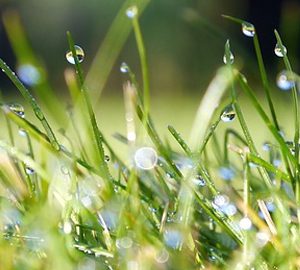
Growing Grass from Seed
Grow Your Own Lawn From Seed
The most important considerations in establishing a new lawn are drainage, soil quality, seedbed preparation, choice of seed, fertility and moisture.
When to Plant Grass Seed
If you choose to plant your new lawn in the spring, begin just as soon as the soil is dry enough to work, preferably mid-April to mid-May. This will give your new grass time to get well established before the hot, dry weather sets in.
Fall is the best time to plant grass seed in Ontario, from mid-August to the end of September. Your seedbed is less likely to dry out at this time of year, and the grass should be well established before winter.
The area to be seeded should be as level as possible, with a gentle slope away from buildings. If possible, avoid steep slopes or terraces where water may erode or wash away topsoil. The entire surface should have a layer of good topsoil about 12 to 15 cm deep. It may be advisable to mix peat moss or composted manure into your topsoil for best results.
How to Seed Grass
The Seedbed
Rake the surface thoroughly to prepare the seedbed and avoid any depressions that may hold surface water. Apply a good quality fertilizer, preferably with an analysis on a 1-2-1 ratio, the middle number representing the proportion of phosphorous. This will assist in developing a healthy root system. Rake the surface again before seeding.
Choosing and Planting the Seed
It pays to select good-quality seeds. It is also wise to choose a mixture of at least two or three turfgrass varieties in accordance with your requirements. This will depend on sun and shade conditions. Don’t skimp when seeding. It is best to use a mechanical spreader, although small areas may be hand seeded. Distribute the seed as evenly as possible, applying half the seed travelling back and forth, crossing your first pattern at 90° with the balance of the seed.
Rake lightly, then roll lightly to ensure that the seed is in firm contact with the soil. Water slowly and evenly until 2.5 cm of topsoil is thoroughly moist, and keep the soil moist until grass seedlings are well established. Avoid creating puddles.
Specific Types Of Grass Seed
Choosing the appropriate grass seed mix is crucial for establishing a healthy and resilient lawn. In Ontario, cool-season grasses are ideal due to their ability to thrive in cooler temperatures. Most grass seed mixes are formulated with a combination of several grass types to balance qualities like shade tolerance, drought resistance, and fast germination. Here are some of the most common types of grass seed found in these mixes:
Kentucky Bluegrass: Known for its dark green color and fine texture, Kentucky bluegrass is a popular choice for lawns. It prefers sunny locations and well-drained soils. However, it requires regular maintenance and may not perform well in shaded areas.
Fine Fescues: This group includes grasses like creeping red fescue, chewings fescue, and hard fescue. They are shade-tolerant, have low fertilizer requirements, and can adapt to a wide range of soils. Fine fescues are ideal for areas with poor, sandy, or acidic soils where other grasses might not thrive.
Perennial Ryegrass: This grass germinates quickly and provides rapid cover, making it suitable for overseeding and repairing damaged lawns. It has a fine texture and is often used in mixtures to enhance wear tolerance. However, it is less winter-hardy compared to other cool-season grasses.
Tall Fescue: Known for its drought and heat tolerance, tall fescue is suitable for areas prone to dry conditions. It has a deep root system and performs well in various soil types. Turf-type tall fescues have been developed for improved texture and density.
Most grass seed is sold in blended mixes containing different percentages of these grass types. When choosing a mix, consider the specific needs of your lawn. For example, if your priority is quick establishment, look for a mix with a high percentage of Perennial Ryegrass. If your yard has a lot of shade, opt for a mix with plenty of Fine Fescues. The right combination will help ensure a healthy and long-lasting lawn suited to your environment.
Using Peat Moss in Lawn Establishment
Peat moss is not a type of grass seed but rather a soil amendment that can improve soil structure, moisture retention, and provide a conducive environment for seed germination. Incorporating peat moss into the topsoil before seeding can enhance the establishment of your lawn.
Tending the New Lawn
When new grass has grown to a height of 6 to 8 cm, it may be cut, but not to shorter than 4 to 5 cm. Do not let the grass grow so long that it will not stand upright. Ensure that your mower blade is sharp to avoid unnecessary bruising of the grass plants. While there must be reasonable growth of leaves to develop a healthy root system, mow the lawn regularly so cuttings will be only 12 to 15 mm long. This avoids having to remove cuttings.
Feeding A New Lawn
If you start your lawn in the spring, it will require feeding again in late June and again in the fall. For this first feeding, use half the rate recommended on the fertilizer package. Use the full recommendation for the fall feeding.
What About Weeds?
If you have been careful to put down good topsoil, weeds during the early growth of your new lawn should not be a big problem. Some careful hand weeding is best for the first few weeds that appear during the first four to six weeks.
After a new lawn has been cut at least twice, you may apply a weed control product if necessary, but be sure to follow the directions on the package very carefully.
Overseeding Can Improve Your Lawn
Your lawn will continue to improve with age if you follow these simple rules:
- Keep your lawn free of weeds, either by hand weeding or with a weed control product.
- Fertilize your lawn at least three times a year, following directions on the package.
- Each spring or fall, after cutting the grass very short, rake thoroughly and, if necessary, add a little top dressing.
- If the soil appears hard and compacted, go over it with an aerating roller, then top dress and reseed as above.
- Try and keep your lawn cut to about 5 cm in height, and avoid leaving cuttings longer than 12 to 15 mm on the lawn after mowing.
